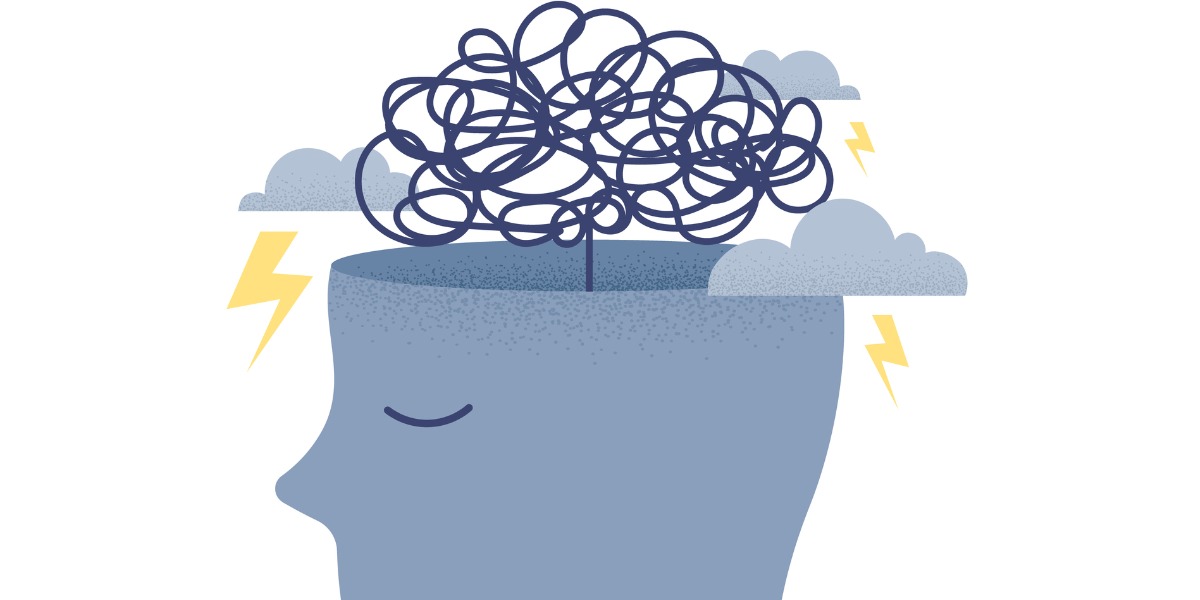In the 21st century, we view mental health disorders – including those caused by trauma – as medical conditions rooted in physiological pathologies, genetic abnormalities, or changes in the brain resulting from illness or injury. This is a contrast to the 19th and early 20th centuries, when we attributed mental and emotional disorders to a wide array of non-medical and non-scientific causes.
We now understand that mental health disorders such as depression, anxiety, bipolar disorder, borderline personality disorder, schizophrenia, and others most often have a genetic component, an environmental component, and an experiential component. Meaning that when a person develops a mental health disorder, there’s typically more than one cause. The disorder is most often the result of a combination of heredity factors, basic life circumstances, and individual experience.
One type of individual experience drastically increases the likelihood an individual will develop a mental health disorder: trauma. Specifically, complex emotional trauma caused by extreme events.
Here’s how the American Psychological Association (APA) defines this type of trauma:
“Trauma is an emotional response to a terrible event like an accident, rape, or natural disaster. Immediately after the event, shock and denial are typical. Longer term reactions include unpredictable emotions, flashbacks, strained relationships, and even physical symptoms like headaches or nausea.”
Trauma is similar to physical injury in that it can occur in an instant but typically takes longer than an instant to recover. Trauma and physical injury are different in that most physical injuries reach a point where doctors call them healed within weeks or months – excluding severe, complex injuries from major accidents, of course – and the body returns to a state almost identical to that which preceded the incident. Emotional trauma – often called complex trauma – rarely resolve quickly.
In some cases, it may take months or years to overcome.
Trauma: What Happens After a Traumatic Event
People who haven’t experienced severe or complex trauma often have a hard time understanding the consequences of truly traumatic events. Think of it this way: if you have a near miss while driving a car on the freeway, you feel a rush of adrenaline and an array of both psychological and physical symptoms. You may feel nauseous, on edge, jittery, about to cry, or on the verge of anger. Then, after minutes or hours pass, you feel empty, exhausted, and emotionally drained, capable of maybe eating and taking a nap, but not much more.
Now, take those feelings, multiply them exponentially, and then spread them out over months and years. That’s the way trauma survivors describe the aftermath of significant, severe, complex trauma: they often re-live the intensity of the moment, and then re-live the feelings that followed. This can happen over and over for years – and sometimes people are unaware that the feelings and problems they experience are connected to an event or events that happened years in the past.
When a person has a traumatic experience and develops mental health issues as a result, the symptoms can disrupt virtually all aspects of life. The consequences of untreated and unresolved trauma may include, but are not limited to:
- Difficulty maintaining healthy relationships with family members
- Problems forming and maintaining positive relationships with peers
- Turbulent romantic relationships
- Impaired academic/work performance/achievement
- Difficulty finding and maintaining gainful employment
To learn more about the consequence of untreated trauma, please navigate to the blog section of our website and read this article:
What is Trauma-Informed Care for Mental Health Disorders?
We’ve defined trauma and shared the consequences of untreated trauma. We provided this information as a prelude to a discussion of a study published last year on the physiological and functional impact of trauma on the human brain. In that study, researchers examined differences in brain structure and function between people with and without PTSD. Before share the results of that study, however, we’ll quickly review the basic prevalence data on PTSD in the U.S.
Prevalence of PTSD: Facts and Figures
Studies conducted and published by the United States Department of Veteran’s Affairs (NIMH) show the following rates of PTSD among adults in the U.S.:
- Close to 17 million people have PTSD during their lifetime.
- That’s almost 6% of the adult population
- 8% of women
- 4% of men
- Lifetime PTSD by age:
- 18-29: 6.6%
- 30-44: 7.1%
- 45-64: 6.6%
- 65+: 3.2%
- Over 14 million people reported PTSD symptoms during the past year
- That’s almost 5% of the adult population
- 6% of women
- 3% of men
- Past Year PTSD By Age:
- 18-29: 5.4%
- 30-44: 5.7%%
- 45-64: 4.7%
- 65+: 2.2%
- Among adults diagnosed with PTSD:
- 6% reported serious impairment
- 1% reported moderate impairment
- 2% reported mild impairment
That’s the scope of the issue right now. Millions of people in the U.S. have the primary mental health disorder caused by traumatic experiences: post-traumatic stress disorder (PTSD). Without evidence-based treatment and support, the traumatic experiences represented in the statistics above may never resolve, and the victims of trauma may experience significant disruption.
There’s another type of trauma we need to address before we look at the new study we mention above: adverse childhood experiences, or ACEs. In the late 1990s, the Centers for Disease Control (CDC) partnered with Kaiser Permanente Health Systems to study the effect of early trauma on long-term health. We know this research effort as the ACE Study, which experts recognize as the origin what we now call trauma-informed care.
Adverse Childhood Experiences:
Events That Cause Long-Term Physical and Emotional Problems
The ACE Study identified the following adverse childhood experiences, or ACEs:
- Physical, emotional, or sexual abuse
- Physical or emotional neglect
- Domestic violence
- Divorce of parents
- Living with an individual struggling with substance abuse, an individual diagnosed as mentally ill or an individual who was incarcerated or sentenced to be incarcerated
- Experiencing racism and/or bullying
- Living in foster homes
- Living in an unsafe neighborhood
- Witnessing violence
People exposed to at least four ACEs are at increased risk of developing emotional, psychological, and physical problems later in life. We mention the impact of trauma on long-term health in the first paragraph of this article.
Now let’s take a look at that study – and learn whether scientists have new insight on how and why trauma – early or otherwise – can cause subsequent pathology.
Trauma and the Brain: What Changes, Compared to People Without PTSD?
In the publication ”Sequential Fear Generalization and Network Connectivity In Trauma Exposed Humans With And Without Psychopathology,” researchers used advanced imaging technology to analyze difference in brain structure and function in real time between people with and without PTSD. The research team indicates that more than one third of people exposed to traumatic events are at increased risk of developing a clinical mental health disorder.
The diagnoses most often associated with trauma include:
- Posttraumatic stress disorder (PTSD)
- Panic disorder (PD)
- Generalized anxiety disorder (GAD)
- Major depression disorder (MDD)
Common traumatic events – in addition to the ACEs we mention above – include:
- Living in a war zone
- Living through a natural disaster/disasters
- Experiencing assault
- Experiencing/witnessing terrorism
However, despite our extensive knowledge on trauma and its consequences, we know very little about the physiology of trauma. The research team indicates this lack of knowledge is the result of an over-reliance on traditional diagnostic approaches, and an under-utilization of new imaging technologies such as magnetic resonance imaging (MRI) and functional magnetic resonance imaging (fMRI). In addition, previous research that leverages these technologies focused on people with PTSD, and did not include healthy controls, making physiological comparisons impossible.
That’s why the research team devised this study. Here’s how they describe their work:
“In an effort to address these gaps in knowledge, the present study aimed to clarify the behavioral and network functional magnetic resonance imaging (fMRI) markers of trauma and resilience in trauma-exposed people with and without psychopathology, and among people who were never exposed to trauma.”
Let’s look at how they did it.
PTSD and Brain Changes: Healthy Controls and Trauma-Exposed Individuals
To fill the gaps in knowledge they identified, researchers recruited a total of 144 adult participants. Thorough screening resulted in some exclusion, leaving a total sample set of 88 participants. Among these participants:
- 26 had no history of trauma. These individuals were the healthy control group, or the HC group.
- 31 had a history of trauma and a diagnosed psychopathology (mental health disorder). These individuals were the experimental group, or the TEPG (trauma-exposed with pathology).
- All patients in this group had PTSD.
- 11 had major depressive disorder (MDD)
- 5 had persistent depressive disorder (PDD)
- 3 had panic disorder (PD)
- Others had OCD, ADD, insomnia, an eating disorder, subthreshold PTSD, or subthreshold MDD
- 31 had a history of trauma and no diagnosed psychopathology. These individuals were the experimental control group, or the TEHC (trauma-exposed healthy control).
Researchers identified the brain areas associated with post-traumatic stress disorder, major depressive disorder, and anxiety disorders, including the:
Default mode network (DMN):
This network of brain systems is active when the brain is at rest, and not focused on the outside world.
Salience network (SN):
This network of brain systems identifies stimuli in the outside world, and coordinates both emotional and physical responses to external stimuli.
Executive control network (ECN):
This network is responsible for integrating and managing attention, emotion, sensory input, memory, and decision-making.
Next, researchers conducted a short series of tests to measure the relative activity in these brain networks, in real time, in response to external stimuli, using fMRI.
Let’s take a look at what they found.
Trauma With PTSD and Trauma Without PTSD: Changes in the Brain
Researchers asked study participants to view several circles of different sizes. One circle was associated with a mild electric shock – highly uncomfortable but not painful – which represented a general threat. Researchers theorized the presence of this threat would cause different brain networks to engage in people with a history of trauma, as compared to people with no history of trauma. They also theorized the presence of a threat would cause different brain networks to engage in different ways in people with a history of trauma with PTSD, as compared to people with a history of trauma without PTSD.
Spoiler alert: the experimental results confirmed much of what the research team theorized. Here are the differences they identified:
- Trauma-exposed (TE) participants showed higher overall risk ratings for pathology than healthy controls (HC).
- Trauma-exposed healthy controls (TEHC) and HC showed lower overall risk ratings for pathology than trauma exposed participants with psychopathology (TEPG).
- HC individuals showed higher levels of activity in the salience network (SN) and the executive control network (ECN) compared to individuals in the TEHC and TEPG groups.
- The TE group showed poor discrimination in identifying threats, as measured by increased activity in the SN and ECN, as compared to the HC group.
- The TEHC group showed lower ECN activity, compared to the TEPG group.
- The TEPG group showed higher ECN activity, compared to the TEHC group.
These results suggest, first, that trauma-exposed individuals are less efficient at detecting threats, overall, and less efficient at integrating information about those threats into the decision-making process governed by the executive control network.
Next, we’ll share an interesting wrinkle in the data.
Executive Control, Emotion, and Discernment
When comparing results among trauma-exposed participants, researchers observed more activity in the ECN in participants with PTSD (TEPG) than those without PTSD (TEHC) when assessing threats. This suggests that people exposed to trauma who did not have PTSD developed a more efficient executive control system than people exposed to trauma who did have PTSD. Here’s how the study authors describe this result:
“Knowing what to look for in the brain when someone is exposed to trauma could significantly advance treatments. In this case, we know where a change is happening in the brain and how some people can work around that change. It is a marker of resilience.”
In addition, researchers observed less communication between brain areas associated with emotion and brain areas associated with control and integration in trauma-exposed participants, as compared to participants with no history of trauma. That result may explain the presence of PTSD in the TEPG group: the functional network responsible for integrating threats may be overwhelmed by other brain networks, resulting in pathology.
“It might be that in the real-world emotions overload their cognitive ability to discriminate between safety, danger, or reward. It overgeneralizes towards danger. [These] findings…uncover neural and behavioral mechanisms of trauma, PTSD and resilience, and help to extend our knowledge about the effect of trauma on the brain.”
Finally, researchers indicate that non-invasive stimulation of the brain areas identified as deficient with techniques like transcranial magnetic stimulation (TMS) may be a promising treatment approach, based on these results.
That’s important news for people with PTSD, and external validation that one of our primary therapeutic techniques at Crownview Psychiatric Institute – TMS – may be part of an entirely new approach to diagnosing and treating patients with PTSD.


 Gianna Melendez
Gianna Melendez Jodie Dahl, CpHT
Jodie Dahl, CpHT